From the experts
Growing up, you were inundated with well-meaning advice: Don’t run with scissors! Wait a half hour after eating before you go swimming! You’ll shoot your eye out! As a kid, you probably didn’t take these warnings too seriously.
As the owner of a welding generator with a Kohler® Command overhead valve gas engine—such as Miller’s Bobcat™Trailblazer™ series —you still get bombarded with advice: Change the oil! Change the filters! Don’t use old fuel! However, unlike childhood warnings, this advice is essential. Good maintenance:
- Extends engine/welder life
- Ensures peak performance at all times
- Maintains reliability/avoiding costly breakdowns
- Prevents voiding warranty coverage
- Maximizes resale value
Unfortunately, up to half of all engine drive owners don’t follow proper maintenance procedures. Hopefully, the technical information provided in this article will shed more light on the consequences of poor maintenance and inspire better care.
Read the manual
Manufacturers of engines and engine-driven welding generators work together to continuously improve products, add new features and upgrade existing technology (10,500 watts of peak generator power is one such example). Ultimately, it’s up to you to know how to properly maintain your machine. Read the owner’s manual cover-to-cover and familiarize yourself with your engine drive.
Some welder generator manufacturers make it easy to remember routine maintenance. The schedules are printed on the air filter cover and inside the engine compartment’s side door (see Fig. 1 and Fig. 2). If you lost your owner’s manual, you can download free owner’s manuals online. Just go to http://www.MillerWelds.com/service for the entire welding generator manual, or go to www.kohlerplus.com for any of the Command manuals.
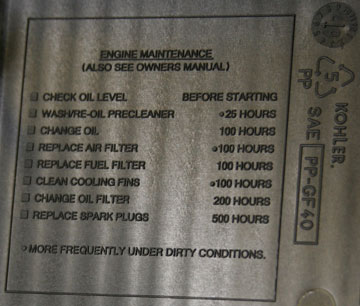 |
|
Fig. 1: As a reminder, engine manufacturers list routine maintenance items and their part numbers on the air filter housing cover.
|
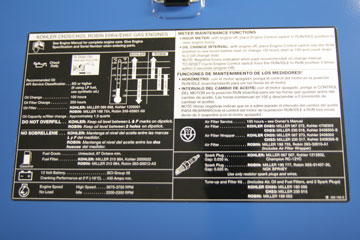 |
|
Fig. 2: Engine drive manufacturers such as Miller print a list of routine maintenance items and their part numbers inside the engine access door.
|
The lifeblood of your engine
Oil is necessary to lubricate the internal components of the engine, dissipate heat and prevent corrosion. Running your engine with low oil will damage the engine and eventually result in a catastrophic failure.
Motor oil is available in a variety of brands, grades and viscosity. Use a multi-viscosity, SAE SJ grade or better oil. Kohler recommends a 10W-30 weight motor oil, which provides adequate protection in most environments. If you work in extremely cold environments (0 degrees Fahrenheit or colder), use a 5W-30 oil, as it circulates more easily during cold starts.
More expensive synthetic motor oil generally provides better protection of engine components compared to traditional mineral based motor oils. Synthetic oils tend to create a better bond with internal components, reducing motor wear. Kohler approves the use of synthetic oil in all of its engines, but Kohler recommends mineral based oil for the first 50 hours of engine break-in.
Perform regular oil changes
Motor oil loses its lubrication properties with use. Friction then increases, creating microscopic metallic particles that enter the oil stream, causing grinding within moving parts and leading to premature wear. In extreme cases, the oil completely loses its lubrication properties and the engine seizes. Miller and Kohler recommend oil changes every 100 hours to maintain optimum performance.
To remind you, Miller’s newest generation of twin cylinder gas engine drives feature an oil change maintenance meter (see Fig. 3). The meter even does a negative countdown, providing a constant reminder of how many hours you’re being neglectful. Miller also offers an optional remote oil drain that increases convenience in truck-mounted applications (see Fig. 4).
 |
|
Fig. 3: The Miller Bobcat and Trailblazer engine drives feature maintenance meters that remind you to change your oil every 100 hours of operation. The meters count down from 100 hours and count up if you operate your machine in excess of 100 hours without an oil change.
|
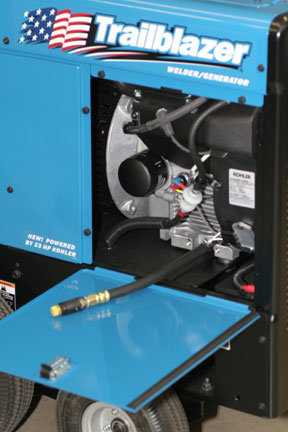 |
|
Fig. 4: This Trailblazer engine drive features an optional remote oil drain, which makes changing the oil much easier in truck-mounted applications (no need to remove the machine from the truck).
|
The importance of oil level
Whenever you change your motor oil, put in the correct amount: do not over- or under-fill. The Kohler Command motor found on the Miller Legend, Bobcat and Trailblazer welder generators requires 1.6 quarts of motor oil if completely drained or 10.71 Fl. Oz. to go from “L” to “F” on the dipstick.
If you over-fill the engine, it may reduce generator power and welding output.
The excess oil gets forced through the breather system, vented out the crankcase and pushed into the carburetor. As a result, the exhaust system belches smoke and the generator/welding output is reduced because of not getting enough fuel.
In addition, too much oil may lead to fuel pump failure. The fuel pump works off crankcase vacuum. If oil gets in the backside of the pump diaphragm, it prevents the pump from moving and it won’t transfer fuel. If you notice oil seeping out of the fuel pump breather, immediately bring the oil level down and replace the fuel pump.
Under-filling your engine can lead to catastrophic engine failure. Without proper lubrication, the connecting rods on the main bearing journal on the crankshaft will seize. The probable result? Snapping a rod or even putting a rod through a crankcase. Further, damage caused by insufficient oil is considered owner neglect and is not covered by warranty.
The other danger with under-filling the oil is the fact that oil cools the engine. Without proper cooling, the oil degrades even faster. It boils off the light ends, leading to lack of oil performance and catastrophic failure. All Kohler engines made for Miller have a low oil shutdown sensor. However, this is a backup system to save the engine. It is not a substitute for good maintenance!
Unlike modern electronic fuel injected automobile engines, twin cylinder carbureted engines commonly found on welder generators consume oil—about 0.5 oz. per hour (note that the engine will burn a little more oil during its first 50 hours of use while the rings seat in). Kohler recommends checking the oil level on its engines every 8 hours, so make it part of your routine to check the oil (see Fig. 5) every time you fill the gas tank or at the start of every shift.
To correctly check the oil level on a Miller engine drive with a Kohler engine, clean the dipstick, drop it in and twist it backwards until it “falls down” on the thread. While you might want to instinctively screw the cap down, don’t do it.
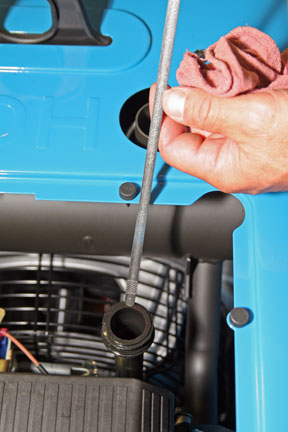 |
|
Fig. 5: Engine-driven welders consume about 0.5 ounce of oil for every hour of run time. Always check the oil level before starting the engine, at the start of each shift or when you fill the gas tank.
|
Check the oil filter
An oil filter (see Fig. 6) removes metallic particles and other contaminants from the oil. Kohler recommends changing your oil filter every 200 hours (or every other oil change). If you don’t regularly change the filter, it eventually becomes clogged with impurities that restrict oil flow. Kohler’s oil filter features a bypass that, in extreme cases, allows dirty oil to pass through so the engine is not starved of lubrication. However, dirty oil causes premature wear on the engine’s bearing surfaces. Bottom line, change the oil filter.
To ensure proper performance, always use genuine Miller oil filters (which Kohler produces for Miller). Unapproved oil filters could have the incorrect amount of filtration media, or filtration media of the wrong size, which in extreme cases may lead to engine damage (which is why using unapproved filters voids the engine warranty).
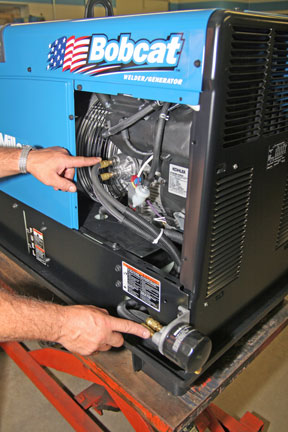 |
|
Fig. 6: Change the oil filter every 200 hours to prevent premature wear on the engine’s bearing surfaces. To permit easy access in truck-mounted applications, Miller offers a remote oil filter kit (shown here) that located the filter outside of the main engine compartment.
|
Fuel for energy
The Command motors in the Miller Legend, Trailblazer and Bobcat can use any unleaded fuel with an octane rating of 87 or greater. Kohler engines operate without pre-detonation or knock because the timing is designed to accommodate octane ratings from 87 to 93.
Always use clean, fresh fuel. When stale fuel is burned, it creates varnish that gums up the carburetor. Problems caused by stale fuel use aren’t covered under warranty.
Fuel stays fresh for about three months (less for reformulated gasoline that has 10 percent ethanol). If you don’t plan to use your engine drive for more than 90 days, add a fuel stabilizer at the same time you fill up. Kohler has tested non-reformulated fuel with a leading brand of stabilizer and confirmed that the fuel still has its normal characteristics after approximately one year. People who use an engine drive for emergency generator power should especially heed this advice.
Note that there is a huge misconception about stabilizer refreshing stale fuel. It doesn’t. It only helps fuel from going stale.
Another danger of using old fuel is that it might not be the right seasonal blend. Refiners vary gasoline’s formula throughout the year. Summer blends have a lower vapor pressure so the engine won’t vapor lock. Winter blends vaporize easier for better starting. That’s great in colder temperatures…but if you try to use winter fuel in a summer application, it will vaporize too easily and can lead to vapor forming in the fuel pump, the fuel filter and the carburetor. This will cause vapor lock and the motor will not run.
A cold weather note
With the right viscosity oil, all Kohler Command engines are rated for starting at –20 degrees F. The only winter maintenance item that might be necessary is an anti-icing kit. It solves problems with carburetor icing, which usually happens between 30 and 38 degrees on high humidity days. Any Kohler authorized service center can install this kit, or you can do it yourself. The use of an isopropyl alcohol-based de-icer, mixed per the manufacturer’s recommendation, can help with carb icing problems by pulling moisture (condensation) out of the fuel tank.
If you need to replace the battery on your engine drive, note that Miller uses a 435 CCA battery, one of the most powerful batteries used on twin cylinder engine drives. To maintain good cold weather starting performance, use Miller Genuine Parts.
Avoid E85
Due to the public’s increasing interest in alternative energy sources, an ethanol-based fuel, known as E85, is becoming widely available. E85 is an alcohol fuel mixture that contains a mixture of up to 85 percent denatured fuel ethanol and 15 percent gasoline by volume. Never use E85 in Kohler Command or any other carbureted engine. The ethanol attacks and corrodes the rubber, brass and aluminum fittings within the carburetor and will ruin the engine in just 15 minutes. Reformulated gas is okay to use in all Kohler carbureted engines, but it will be less energy-efficient than 100 percent gas.
The fuel filter
The fuel filter (see Fig. 7) removes contaminants from the fuel before it reaches the carburetor chamber. The fuel filter should be replaced every 200 hours or any time that you suspect that you’ve filled up the tank with a bad batch of gas. If the filter gets too dirty, it will restrict the amount of fuel that travels to the carburetor, which results in a “lean” air/fuel ratio. The lean ratio will inevitably reduce the generator power available and lower welding output.
As with the oil filter and air filter (noted below), using Miller Genuine Parts guarantees that you’re using a filter designed for optimum performance with your engine drive.
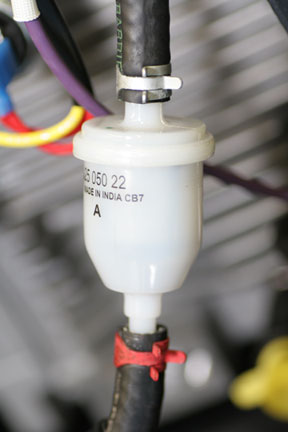 |
|
Fig. 7: Replace the fuel filter every 200 hours or when you know you filled up with a bad batch of gas.
|
Replace the air filter
Kohler engines use a pre-cleaner in addition to the main filter (see Fig. 8), which removes larger sized particles from the intake air. The main cleaner removes finer particles before they reach the carburetor.
At the very minimum, replace the air filter every 200 hours and more frequently if you use your welder generator in extremely dirty and dusty environments. An extremely dirty air filter prevents the proper amount of air from reaching the carburetor. As a result, the engine runs “rich” (too much fuel and not enough air), which fouls the spark plugs and reduces generator output and power at the arc.
If you place a heavy load on an engine drive with a clogged filter, such as running a 5/64-in. diameter flux cored wire, you might not get all the power you need to weld at maximum efficiency. Further, you’ll see a slower acceleration from idle rpm to run speed rpm. When you need immediate power, you won’t get it if you have a dirty air filter; there’s simply not enough air to ignite all the fuel present.
While changing your air filter regularly seems like common sense, air filter problems are a leading cause of warranty claims. In fact, if a filter becomes too clogged, it creates a huge vacuum draw that pulls dirt into the system through any crack available. Dirt can get pulled into the fuel system, work its way into the cylinder and erode the cylinder walls (this is known in the engine repair business as “dusting an engine”).
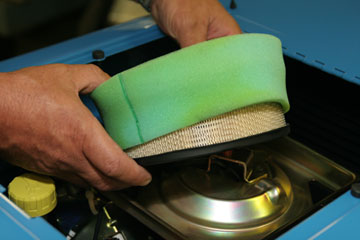 |
|
Fig. 8: Replace your air filter every 200 hours. Kohler engines use a pre-filter (green component) to remove larger sized particles while the main air filter (white) removes finer particulate. The pre-filter can be cleaned with soapy water, lubed with 10W-30 oil (note oil discoloration on this new filter) and reused.
|
Cool off
Air-cooled engines rely on a fan to bring in fresh, cool air to dissipate excess engine heat. Often, the fan and the cooling fins become clogged with dust and other contaminants. To keep your machine running cool, use compressed air to blow out the fan and the cooling fins every 100 hours. It’s a good idea to get into the habit of cleaning out the cooling system every time you change the oil. If the fan cannot adequately cool the motor, the unit will overheat and eventually shut down.
If your engine drive has been sitting idle for a while, look inside for mouse nests or rodent building materials. This is a common problem with engine drives stored in barns, sheds or under porches. Upon start-up, a mouse nest usually gets sucked into the cooling system and clogs it.
The spark within the system
Spark plugs produce an electric arc that ignites the compressed fuel and air within the cylinder. To ensure that the spark plugs continue to provide reliable ignition, replace the spark plugs every 500 hours.
The distance between the spark plug’s electrode and tang plays a vital role in reliable ignition (see Fig. 9). Refer to your engine’s owner’s manual to determine the optimum gap. You can measure the spark plug gap with a gauge available at automotive parts stores for as little as 75 cents. If the gap is too small, it might not create a large enough “flame front” for proper ignition. An excessive gap strains the ignition system because the arc will have to work harder to jump from the electrode to the spark plug tang. You also want to make sure that the electrode is perfectly perpendicular to the tang. If it is bent, replace the spark plug.
By examining the condition of the spark plugs, you can also determine if your machine is running too rich or too lean. A spark plug covered with a white coating indicates that the engine is running too lean, which could mean you have a clogged or dirty fuel filter. Conversely, a spark plug covered with soot means that the engine is running too rich and you should check or clean the air filter. To clean a dirty spark plug, remove the soot with a wire brush.
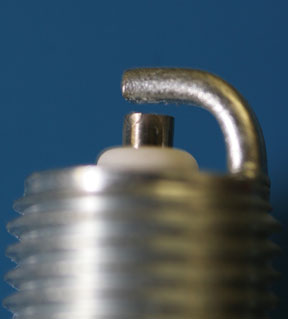 |
|
Fig. 9: Make sure your spark plugs are in good condition. Use a set of feeler gauges to check the gap between the tang and the electrode. Replace the spark plugs if they are damaged.
|
Idle adjustment
Miller factory sets and tests each engine drive for an idle speed of 2400 rpm (and a run speed of 3700 rpm). A fast idle speed won’t cause any problems, but it wastes fuel and creates more noise. An idle speed lower than 2350 rpm, could cause the engine to bog down when you try to strike an arc or put a heavy motor load on it. The engine will have a harder time coming up to appropriate speed, so checking the idle (see Fig. 10 and Fig. 11) is very important for good performance
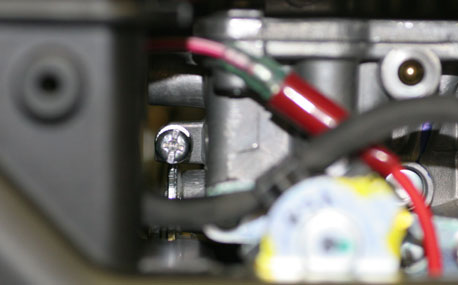 |
|
Fig. 10: For optimum performance on a Bobcat or Trailblazer, use a Phillips screwdriver (see screw to the lower left of the red wire) to adjust the low idle speed to ±50 rpm of the optimal 2400 rpm. Use a tachometer or frequency meter for accuracy. The frequency meter should read 36 to 38 Hz for 2400 rpm.
|
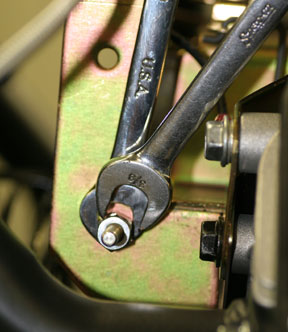 |
|
Fig. 11: Use two wrenches to adjust the engine run speed to 3700 rpm for optimum performance on a Bobcat or Trailblazer.
|
Do it
All of the items and actions discussed can be carried out by anyone with minimum mechanical inclination. The hardest part about routine maintenance is actually making it routine. By getting into the habit of checking these items, your engine drive will run reliably and deliver optimum performance for thousands of hours. As a final note, remember that many people eventually sell their old engine drive when they upgrade to Miller’s latest product. If you can show good engine maintenance records, your engine drive will command a higher resale price.
All of the items and actions discussed can be carried out by anyone with minimum mechanical inclination. The hardest part about routine maintenance is actually making it routine. By getting into the habit of checking these items, your engine drive will run reliably and deliver optimum performance for thousands of hours. As a final note, remember that many people eventually sell their old engine drive when they upgrade to Miller’s latest product. If you can show good engine maintenance records, your engine drive will command a higher resale price.